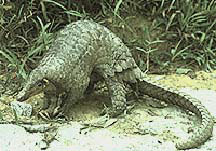
Order Pholidota
| Common name |
pangolin |
| # of Genera |
1 |
| # of Species |
7 |
| Distribution |
Africa, S.E. Asia |


- General characteristics of the order
- Name means "scaly ones"
- Major diagnostic character is the scales that cover their bodies
- Made of keratinized epidermis
- Periodically replaced as they wear and fall out
- Leaf shaped
- Cover top of head, top and sides of body and limbs, and entire tail
- Parts without scales are hairy
- Arboreal ones have prehensile tails, terrestrial ones have short tails
- Long, tubular rostrum
- Long sticky tongues (extends all the way back into the chest cavity when
retracted)
- No teeth
- Horny epithelium with "teeth" in the pyloric region for smashing
insects
- Digging limbs
- Plantigrade
- 5 digits
- Long claws
- Ecology and behavior
- Insectivorous
video
- Some are terrestrial, some arboreal
- Roll into a ball as an antipreditor defense
Order Carnivora
| Comon name
| dogs, cats, bears
|
| Families
| 15
|
| Genera
| 126
|
| Species
| 287
|
| Distribution
| Nearly worldwide
|
- Name means "flesh eater"
- Range in size from least weasel (mouse-sized) to Kodiak brown bear (terrestrial; up to 800 kg) and male southern elephant seal (aquatic; 3600 kg)
- General characteristics
- Teeth
- Canine teeth
- Carnassial pair (blade-like fourth pre-molar and first molar) (Fig. 15.4)
- Sharply defined mandibular fossa, where mandible articulates with cranium (some species)
- Long rostrum with complex turbinal bones
- Well developed anal glands
- Modes of life (terrestrial, semi-aquatic or aquatic)
- Terrestrial and semi-aquatic forms
- Plantigrade or digitigrade (depending on extent of cursoriality)
- Four or five toes to each foot
- Long, sharp claws on all digits
- fusion of wrist bones
- Aquatic forms (pinnipeds)
- Limbs enclosed within body up to knees and elbows
- Elongated metatarsals and metacarpals, webbing between digits to produce flippers
- Large body size
- Blubber
- Nostrils are slits that must be forced open
- Nipples and external genitalia are withdrawn into slits
- Most breed and all give birth on land, molt on land
- Respiratory system adaptations
- Controversy over whether or not pinnipeds probably not are monophyletic
- Once placed in their own order
- Later thought that Otaraiidae and Otobenidae were most closely related to Ursidae (bears) and Phocidae
were most closely related to Mustelidae (weasels)
- Most recently, again considered monophyletic...
- Phylogenetic history and selected families
- Felidae (cats)
skull
- Hyaenidae (hyaenas, aardwolf)
- Herpestidae and Eupleridae (mongooses, meerkats)
skull
- Viverridae (civets)
skull
- Canidae (dogs, wolves, foxes, jackals)
- Mustelidae (weasels, otters)
skull
- Procyonidae (racoons)
- Ursidae (bears)
- Otariidae (eared seals)
- Odobenidae (walrus)
- Phocidae (earless seals)






